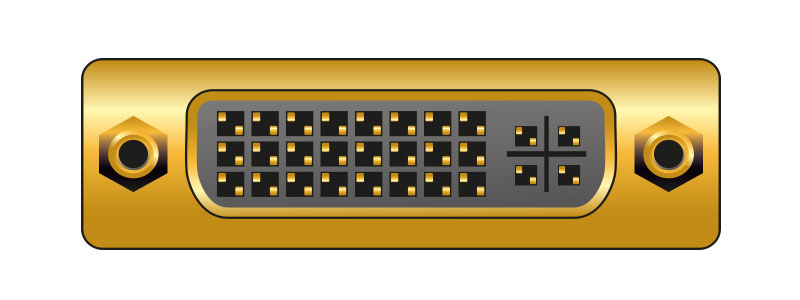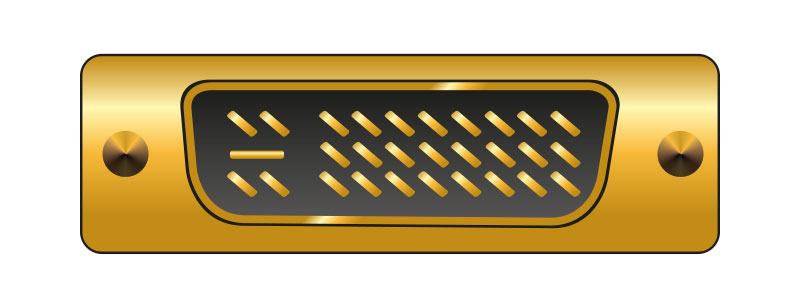In this article:
- What is a DVI-D Dual Link 24+1?
- What is a DVI-D Single Link 18+1?
- What is DVI-I Dual Link 24+5?
- What is Mini DVI?
Digital Visual Interface (DVI) is a video interface standard widely employed for transmitting digital video signals from source devices like computers to display devices such as monitors or projectors. Introduced in the late 1990s, DVI superseded older analog VGA connections, offering enhanced image quality and compatibility with emerging digital displays.
DVI connectors are available in various variants, including DVI-D (digital only), DVI-I (integrated digital and analog), and DVI-A (analog only), catering to different signal types and enabling versatile device connections.
Capable of transmitting high-definition video signals ranging from standard-definition (SD) to high-definition (HD) and beyond, DVI supports both single-link and dual-link configurations. Dual-link DVI provides increased bandwidth for transmitting higher resolutions and refresh rates.
Although newer interface standards like HDMI and DisplayPort have largely replaced DVI in consumer electronics, DVI remains prevalent in specific applications such as older computers, professional display setups, and legacy equipment.
What is a DVI-D Dual Link 24+1?
DVI-D Dual Link 24+1 is a type of Digital Visual Interface (DVI) connector primarily utilized for transmitting digital video signals between computers, monitors, and other display devices. The “24+1” designation signifies that the connector has 24 pins for digital video signals and an additional pin for analog signals, though DVI-D connectors exclusively transmit digital signals, rendering the analog pin unused.


FEMALE MALE
- What are the key features of DVI-D Dual Link connectors?
DVI-D Dual Link connectors support high-definition video transmission with resolutions up to 2560×1600 pixels, making them ideal for demanding applications such as gaming, video editing, and graphic design. They boast a higher bandwidth compared to single-link DVI connectors, facilitating higher resolutions and refresh rates.
- What are the typical cable runs for DVI-D Dual Link connections?
The cable runs for DVI-D Dual Link connections can vary depending on specific requirements and cable quality. For desktop setups and office environments, typical cable lengths range from 3 to 15 feet (1 to 5 meters), connecting computers with DVI outputs to monitors or display hubs.
- What about longer cable runs for professional or home entertainment setups?
In professional installations or home entertainment systems, longer cable runs may be necessary to connect DVI-D Dual Link sources to remote displays or projectors. DVI-D Dual Link cables can typically transmit signals over distances ranging from 15 to 50 feet (5 to 15 meters) or more, contingent upon cable quality and environmental factors.
- How do factors like cable quality and display resolution affect DVI-D Dual Link connections?
Longer cable runs for DVI-D Dual Link connections may necessitate high-quality cables to maintain signal integrity and prevent degradation over extended distances. Factors such as electromagnetic interference and display resolution can also influence the maximum cable length supported in a given setup.
What is a DVI-D Single Link 18+1?
DVI-D Single Link 18+1 is a variant of the Digital Visual Interface (DVI) connector utilised for transmitting digital video signals between computers, monitors, and other display devices. The “18+1” designation signifies that the connector has 18 pins for digital video signals and an additional pin for analog signals, although DVI-D Single Link connectors exclusively transmit digital signals, rendering the analogue pin unused.

- What are the key features of DVI-D Single Link connectors?
DVI-D Single Link connectors are capable of supporting resolutions up to 1920×1200 pixels, making them suitable for standard-definition and high-definition video applications. While they offer a lower bandwidth compared to DVI-D Dual Link connectors, they are still adequate for most desktop and consumer display setups.
- What are the typical cable runs for DVI-D Single Link connections?
Similar to DVI-D Dual Link connections, cable runs for DVI-D Single Link connections can vary based on specific requirements and cable quality. For desktop setups and office environments, typical cable lengths range from 3 to 15 feet (1 to 5 meters), connecting computers with DVI outputs to monitors or display hubs.
- What about longer cable runs for professional or home entertainment setups?
In professional installations or home entertainment systems, longer cable runs may be necessary to connect DVI-D Single Link sources to remote displays or projectors. DVI-D Single Link cables can typically transmit signals over distances ranging from 15 to 50 feet (5 to 15 meters) or more, contingent upon cable quality and environmental factors.
- How do factors like cable quality and display resolution affect DVI-D Single Link connections?
Just like with DVI-D Dual Link connections, longer cable runs for DVI-D Single Link connections may require high-quality cables to maintain signal integrity and prevent degradation over extended distances. Variables such as cable quality, electromagnetic interference, and display resolution can impact the maximum cable length supported in a given setup.
What is DVI-I Dual Link 24+5?
DVI-I Dual Link 24+5 is a type of Digital Visual Interface (DVI) connector designed for transmitting both digital and analog video signals between computers, monitors, and other display devices. The “24+5” designation indicates that the connector has 24 pins for digital video signals and 5 additional pins for analog signals. This allows DVI-I Dual Link connectors to support high-definition digital video transmission with resolutions up to 2560×1600 pixels, as well as analog video transmission for compatibility with older display devices.


- What are the key features of DVI-I Dual Link connectors?
DVI-I Dual Link connectors offer versatility by supporting both digital and analog video signals. They are capable of transmitting high-definition digital video with resolutions up to 2560×1600 pixels while also accommodating analog signals for compatibility with legacy display devices.
- What are the typical cable runs for DVI-I Dual Link connections?
Cable runs for DVI-I Dual Link connections can vary based on specific requirements and cable quality. For desktop setups and office environments, typical cable lengths range from 3 to 15 feet (1 to 5 meters), commonly used to connect computers with DVI outputs to monitors or display hubs.
- What about longer cable runs for professional or home entertainment setups?
In professional installations or home entertainment systems, longer cable runs may be necessary to connect DVI-I Dual Link sources to remote displays or projectors. DVI-I Dual Link cables can typically transmit signals over distances ranging from 15 to 50 feet (5 to 15 meters) or more, depending on cable quality and environmental factors.
- How do factors like cable quality and display resolution affect DVI-I Dual Link connections?
Similar to other DVI connectors, longer cable runs for DVI-I Dual Link connections may require high-quality cables to maintain signal integrity and prevent degradation over extended distances. Factors such as cable quality, electromagnetic interference, and display resolution can influence the maximum cable length supported in a given setup.
- What cables are typically used or suitable for DVI connections?
For DVI connections, commonly used cables include DVI-D, DVI-I, and DVI-A cables. DVI-D cables transmit digital signals only, making them suitable for digital displays. DVI-I cables support both digital and analog signals, offering versatility for various display setups. DVI-A cables transmit analog signals only and are less common in digital display environments. The choice of cable depends on the specific requirements of the display setup and the compatibility with the devices being connected.
What is Mini DVI?
Mini DVI is a compact version of the Digital Visual Interface (DVI) connector primarily utilised by Apple in some of its older Mac computers, particularly MacBook and iMac models from the mid-2000s to the late 2000s. The Mini DVI connector is specifically designed to transmit digital video signals from the computer to an external display device, such as a monitor or projector.

- What are the typical cable runs for Mini DVI connections? Mini DVI cables are commonly employed for connecting Mac computers with Mini DVI outputs to external displays with DVI inputs. The cable runs for Mini DVI connections are typically relatively short, ranging from a few feet to around 10 feet (1 to 3 meters). These shorter cable lengths are suitable for desktop setups or presentations where the computer is positioned near the display device.
- How prevalent are Mini DVI connectors today? It’s important to note that Mini DVI connectors are less prevalent in contemporary technology landscapes. Newer Mac computers have shifted to other display connector standards such as Mini DisplayPort, Thunderbolt, or USB-C. Consequently, Mini DVI cables may be less readily available in the market and may require adapters or converters to connect to modern display devices with different input connectors.
- What are the implications of Mini DVI’s decreasing popularity? As newer Mac computers adopt alternative display connector standards, the availability of Mini DVI cables may diminish over time. Users relying on Mini DVI connections may need to procure adapters or converters to interface with modern display devices featuring different input connectors. It’s essential to consider compatibility and accessibility when utilizing Mini DVI connections in contemporary setups.
- Are there any advantages to using Mini DVI? While Mini DVI connectors may be less common, they still serve as viable options for older Mac computers with compatible outputs. Their compact size makes them suitable for portable devices like laptops, enabling users to connect to external displays for presentations or extended desktop configurations. Additionally, existing Mini DVI cables and adapters may offer cost-effective solutions for connecting legacy devices to DVI-equipped displays.
- How can users adapt Mini DVI connections to modern setups? For users seeking to integrate Mini DVI connections into modern setups, adapters or converters are indispensable. These accessories allow Mini DVI-equipped Mac computers to connect to displays featuring HDMI, DisplayPort, or USB-C inputs, ensuring compatibility with a wide range of contemporary devices. It’s advisable to research and select adapters or converters that meet specific connectivity requirements and support desired display resolutions.